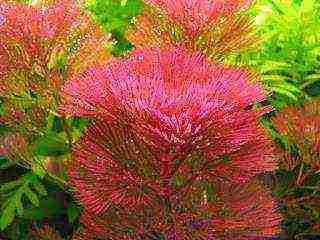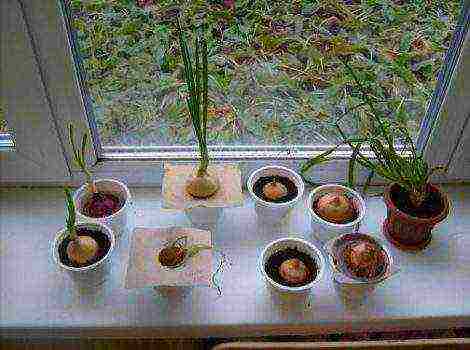Content
- 1 10 tips on how to grow an African snail
- 2 Video about the Achatina snail
- 3 Choose a Vented Snail Container
- 4 Place a thermal mat and thermometer
- 5 Apply a thick layer of backing
- 6 Sprinkle the soil and sides of the container with warm water
- 7 Decorate your terrarium
- 8 Handle the snail carefully
- 9 Feed the giant Achatina vegetables and herbs once a day
- 10 Remove eggs from soil
- 11 Wash the terrarium and change the substrate every week
- 12 Your snail is healthy
- 13 African snail care video
- 14 Characteristics of Achatina
- 15 Buying the Achatina snail - tips
- 16 Terrarium device, filling
- 17 The correct diet of the Achatina snail
- 18 Achatina care
- 19 Health, disease and prevention
- 20 Reproduction at home
- 21 Video about the content of the Achatina snail
- 22 Achatina: who is it?
- 23 General information about shellfish
- 24 How snails mate
- 25 Preparing for breeding
- 26 How is the breeding process carried out
- 27 How to stimulate reproduction
- 28 How to care for a snail during pregnancy
- 29 Achatina snails: reproduction, egg care
- 30 Which clutch of eggs is called false
- 31 Extra eggs: what to do?
- 32 Tiger snails
Achatina is a gastropod molluscs native to hot climates where they are considered voracious pests. In European countries, Achatina is kept at home as an exotic pet.
At home, the African snail grows up to 25 cm in length, and a large pet means happy and healthy.
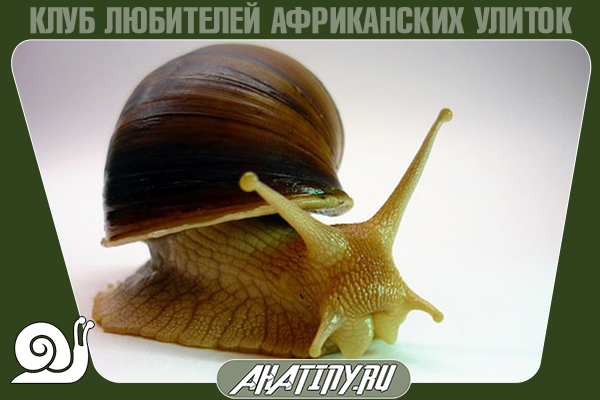
10 tips on how to grow an African snail
1 Buy babies, only at a pet store or from trusted breeders.
Firstly, it is a guarantee that you will get exactly the type of Achatina that you need. Secondly, you can always ask the breeder for help or advice.
2 So that your snail grows by leaps and bounds. Get her a spacious terrarium, food container. The volume of the container in which the Achatina will live should be 5 times the size of an adult animal. This means at least 20 liters. 3 Take care of proper ventilation in the clam dwelling. Punch 4-5 holes on one side of the cage or container, 5 cm below the lid. And the same number of holes on the other wall, only near the ground. Thus, the air will constantly circulate.
Remember to equip the terrarium with a lid so that your pet does not start an independent journey through your apartment.
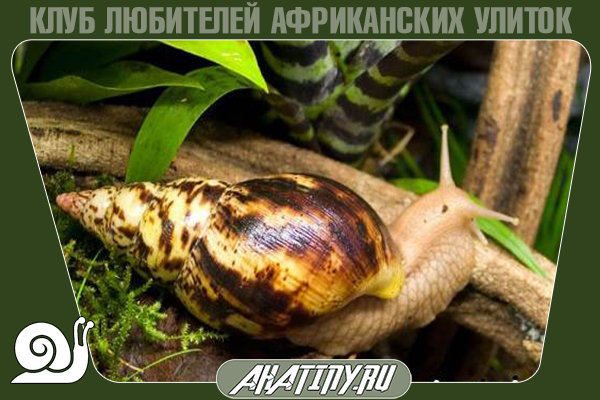
4 Achatina is a land mollusk, so it needs soil for comfortable living at home. How to choose it correctly.
- Firstly, snails sleep in the ground, lay eggs in it.
- Secondly, they eat it, so be careful when choosing a soil. Do not use fertilized soil, sand, sawdust, clay and stones.
- Third, the soil helps maintain constant moisture in the terrarium. Therefore, give preference to coconut substrate, moss, leaf litter, peat and clean soil.
5 It is important to maintain optimum temperature and humidity in the enclosure at all times. Each type of Achatina has its own temperature and humidity. Most often, the temperature ranges from 26 to 29 degrees, and the humidity from 65% to 80%. Look at the behavior of your pet, if it has become inactive, eats poorly, feel free to increase the temperature by 1-2 degrees. If constantly sitting on the wall or ceiling of the terrarium, then it is too humid, reduce the number of irrigations. Many snail breeders specially put some moss in the terrarium, it serves as a kind of indicator of moisture.Greenish - there is enough moisture, dries - spray the terrarium more often.

6 The daily Achatina menu should be varied and balanced. The lion's share of her diet is made up of vegetables and fruits, greens.
Fresh vegetables
- pumpkin;
- cabbage;
- lettuce leaves;
- tomatoes;
- zucchini;
- carrot;
- cucumbers;
- Bell pepper.
Fresh fruits
- pears;
- Strawberry;
- apples;
- watermelon;
- melon;
- apricot;
- bananas.
Greens
- Dill;
- parsley;
- birch leaves;
- oak leaves;
- nettle;
- dandelion;
- plantain.
Do not put food directly on the ground, as uneaten remains of vegetables and fruits in a humid environment quickly deteriorate and mold, gnats and an unpleasant odor appear. How to effectively deal with midges in a terrarium.
Remove leftover food daily to help prevent odors, mold, midges and parasites in the enclosure.
7 For the construction of a beautiful shell, the proper development of all organs and systems, the snail needs calcium.
Sources of calcium
- eggshell;
- sepia;
- food chalk;
- shell rock;
- blue clay.
The most important thing is that calcium is always available to her.
These sources of calcium can be offered all at once, you can alternate. Sepia and edible chalk can be put in a single piece in the terrarium, and the shell rock, eggshells give Achatina only in ground form. Sprinkle food with a calcium mixture, put it in a small pile on the ground - the snail will find it and eat it.

8 Achatina needs protein foods. Its value is important for the health and development of the snail. Protein can be divided into plant and animal proteins. Top dressing recipes for fast snail growth.
Sources of vegetable protein
- oatmeal;
- buckwheat;
- Wheat groats;
- bran;
- corn grits;
- boiled legumes;
- mushrooms;
- nuts.
Sources of animal protein
- gammarus;
- daphnia;
- food for fish;
- bone flour;
- dairy.
You can grind the cereals in a coffee grinder, put them in a jar, and put 1-2 tablespoons daily in a separate bowl or on lettuce and vegetables. Vegetable protein is not as hazardous to shellfish health as animal protein.
The death of the snail is caused by salt, sugar, smoked meats, spicy foods, alcohol, potatoes, onions, citrus fruits and semolina.
You need to be careful with animal protein.
Achatins love it very much, sometimes they refuse to eat other food, so it should be given 2-3 times a week, 1/2 spoonful in order to avoid protein poisoning. And it happens due to the lack of control eating a large amount of animal protein. Why is gammarus dangerous for Achatina? The body of the mollusk swells, secretes a lot of white mucus, and if proper measures are not taken, Achatina dies.
9 Remove food scraps and waste daily. The smell of a snail and its poop do not have, so the source of an unpleasant smell can be a simple lack of hygiene. Try to prevent food from rotting, waterlogging, and flies.
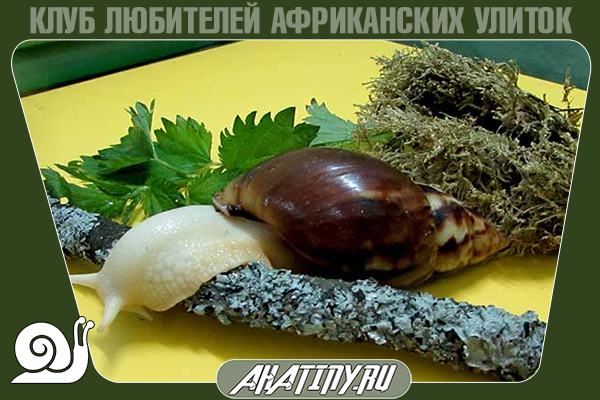
Wash the terrarium once a week, rinse the soil and add a little fresh. Replace worn-out driftwood and moss as needed.
Bathe your pet in warm water once a week. Gently wiping the sink and delicate body with a soft brush or cloth.
When bathing, be careful not to drown or "cook" Achatina under hot water.
After bathing, do not forget to anoint the snail shell with olive or other natural oil. If your snail is very smeared, then you can bathe it more than once a week or put a shallow container of water in the terrarium.
10 The snail is prone to illness and injury. If the above rules are not followed, all your desire to grow a healthy snail can be nullified. If Achatina is bad in the conditions you created, she goes into hibernation until better times. Hibernation for a tropical snail is not typical and is a necessary measure. During suspended animation, the mollusk consumes water reserves and its own reserves.
During hibernation, the animal loses up to 60% of its own weight, and young snails die more often.
Therefore, try to create at home conditions as close as possible to its natural environment. And your two-horned pet will delight you for many years.
Video about the Achatina snail
If you have more information on the successful cultivation of Achatina at home, leave your comment.

East Africa is considered the birthplace of the land snail Achatina. It grows up to 25 cm long. In many countries of Europe and the CIS, the snail is kept as an exotic pet. She is not whimsical to care for and does not require large financial costs for maintenance and feeding. Despite the seeming slowness to us, Achatina can move quickly, it is interesting to watch its movement.
Choose a Vented Snail Container

Keep your homemade Achatina in a well-ventilated glass terrarium (aquarium) or plastic container. Equipped with a secure lid with small holes.
To keep one snail, choose a container about 40 cm long, 25 cm wide and no more than 25 cm high.
Place a thermal mat and thermometer
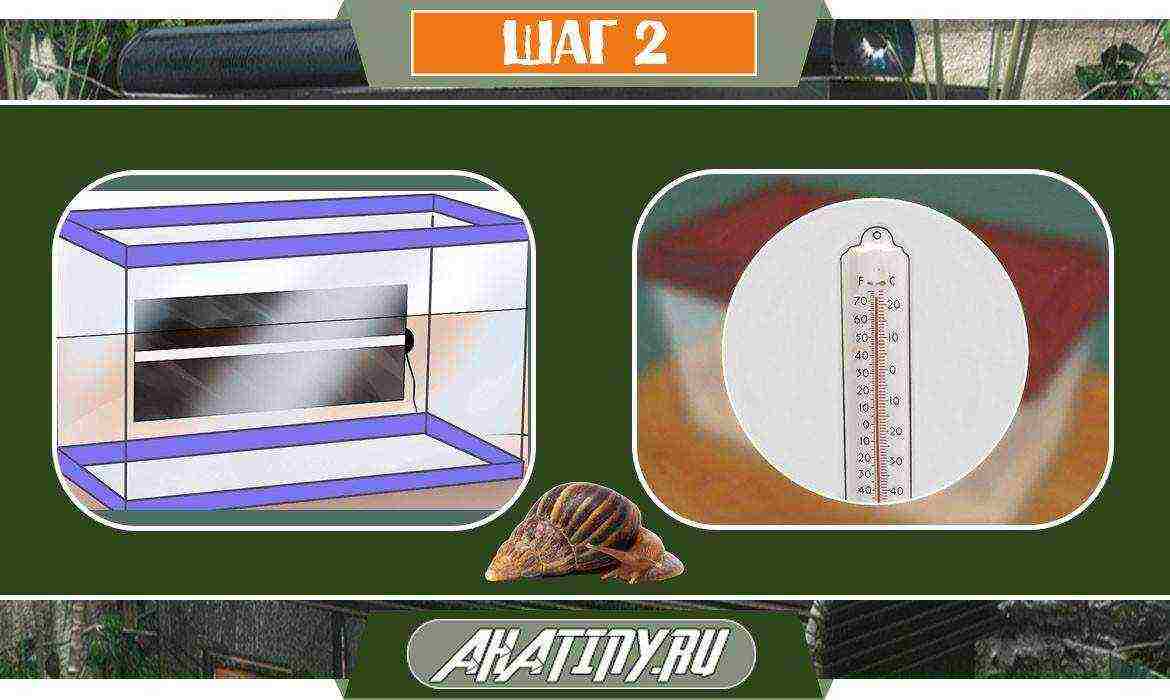
The thermal mat is fixed on the back outer wall or at the bottom of the terrarium. The thermometer is placed over a heat source. The optimum temperature for keeping homemade Achatina is 24-25 degrees.
A thermal mat in the terrarium is optional though.
Apply a thick layer of backing
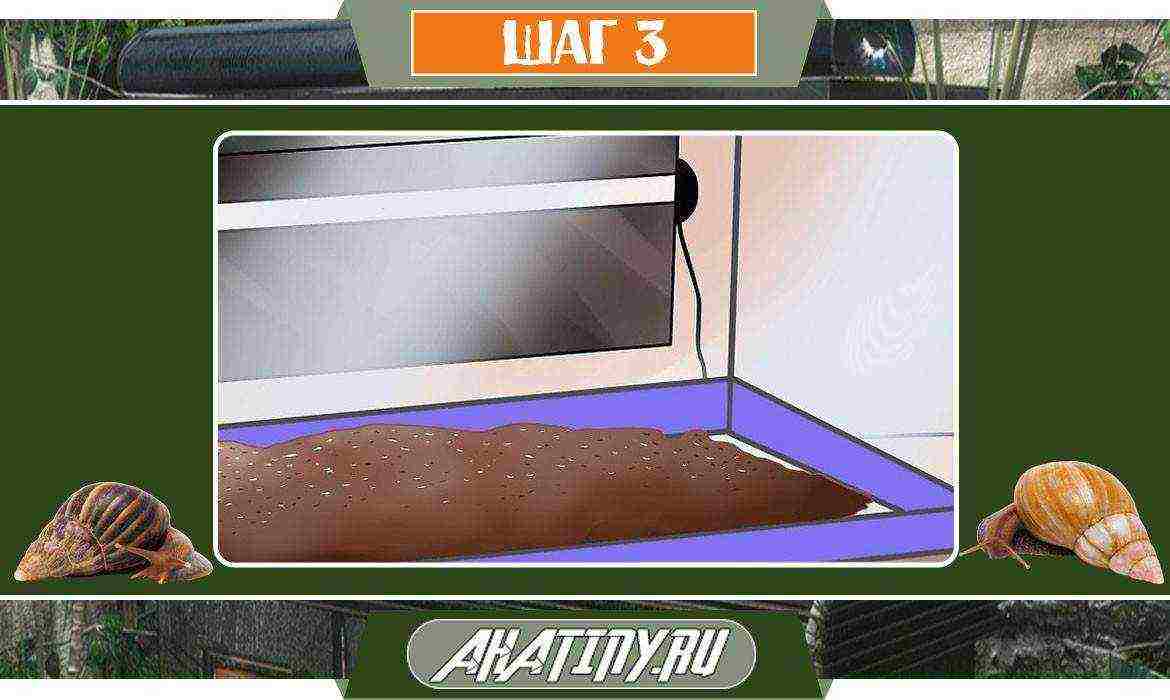
Use coconut substrate or soil for flowers as a soil without fertilizers and pathogens. Avoid sawdust, shells, and pebbles.
Sprinkle the soil and sides of the container with warm water
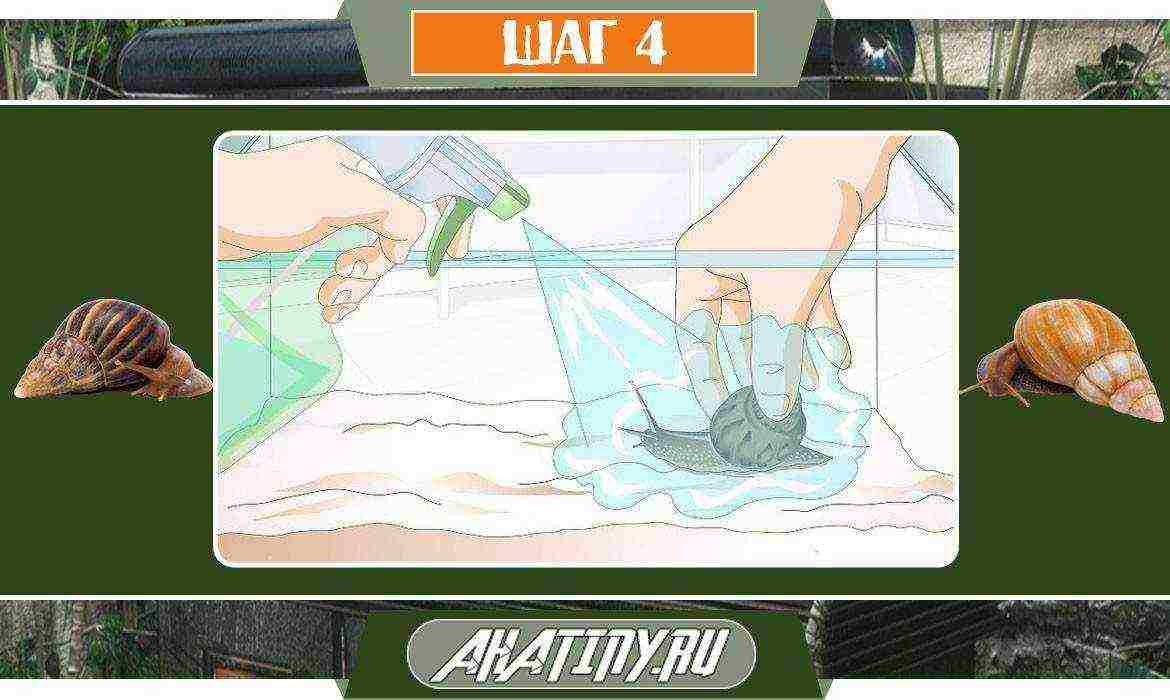
For a comfortable stay of a tropical snail, you need to irrigate the soil daily with warm, settled water. To maintain the humidity level at 60-70%. But don't turn the soil into mud. You can place a shallow container of water in the terrarium. Check humidity with a hygrometer.
Decorate your terrarium

Do not decorate the terrarium with stones or ceramics - the snail can fall and damage the shell on them.
Arrange twisting branches in a container and make moss bumps. From half a plastic flowerpot or coconut, you get a secluded spot for your pet to rest during the day. Plant live plants in the ground, they will decorate your container and serve as additional food for Achatina.
Handle the snail carefully
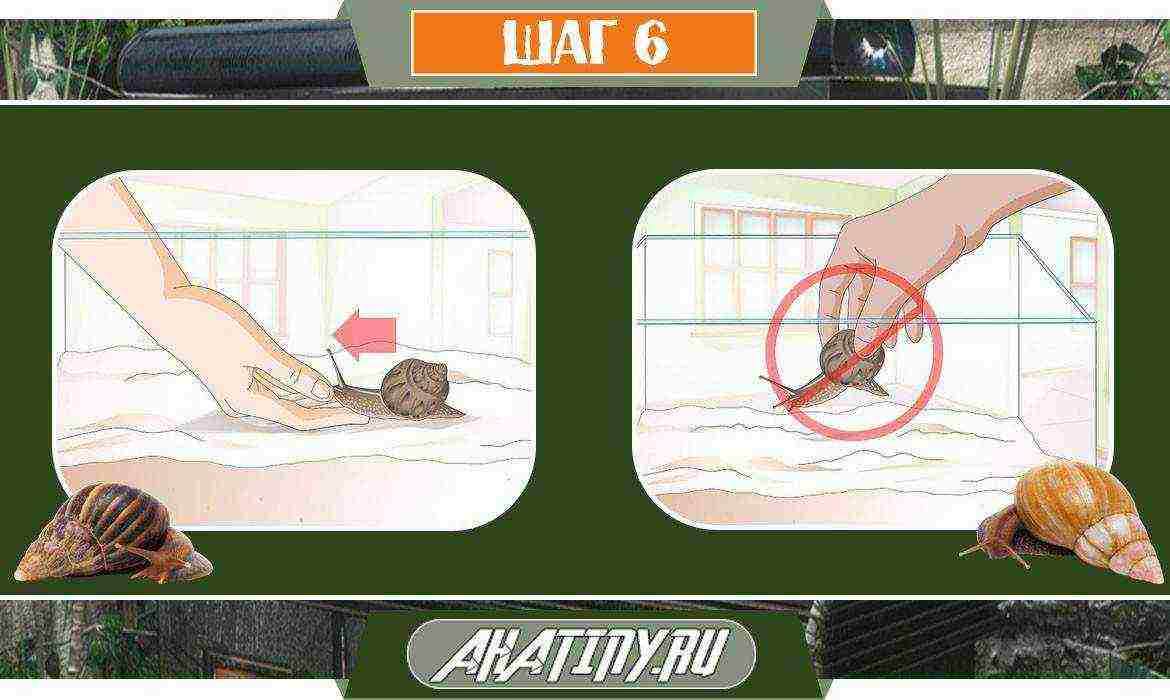
Make sure your palms are clean and damp before handling Achatina. Wash your hands with warm water without soap, as sweat, soap or cream residues are harmful to the snail.
Try to take Achatina not by the sink, but under the sole. Best off the ground, never forcefully pull it off the glass. Do not squeeze the sink too much, you may crush it.
Feed the giant Achatina vegetables and herbs once a day
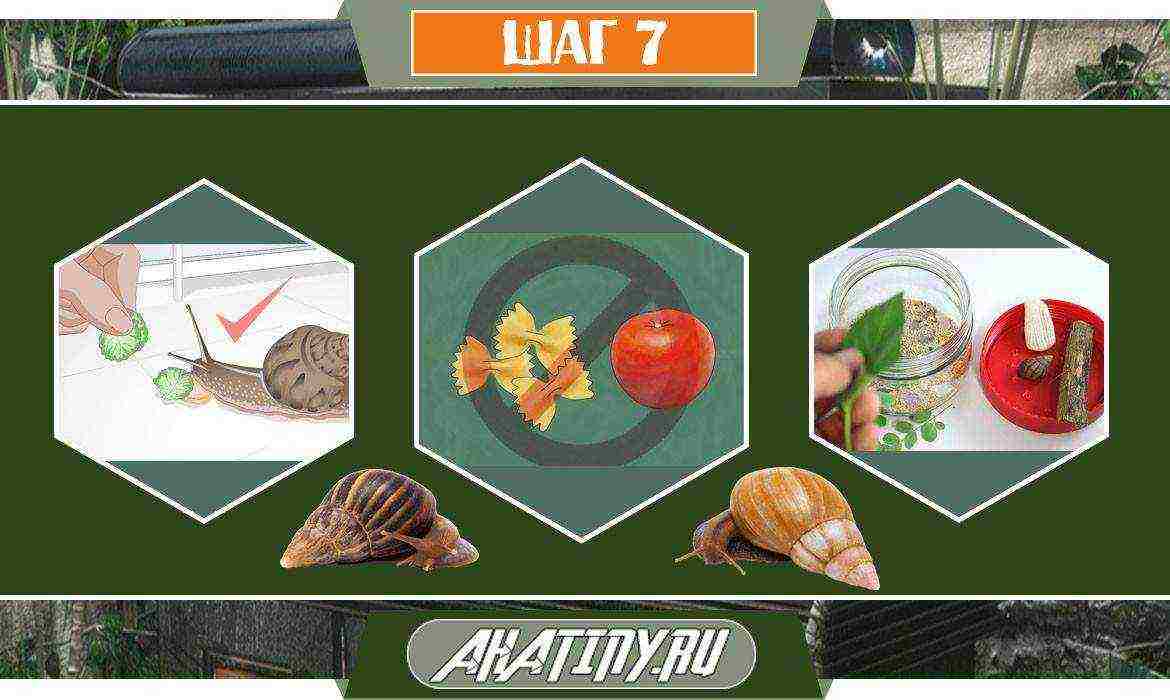
Such as cucumber, cabbage and lettuce. Be sure to wash all vegetables and fruits to remove chemicals. Feed in the evening. Remove leftovers from food the next day.
- for the growth of a beautiful and strong shell, the snail needs calcium. These are ground eggshell, edible chalk and sepia;
- the snail needs a shallow container of clean water.
Remove eggs from soil
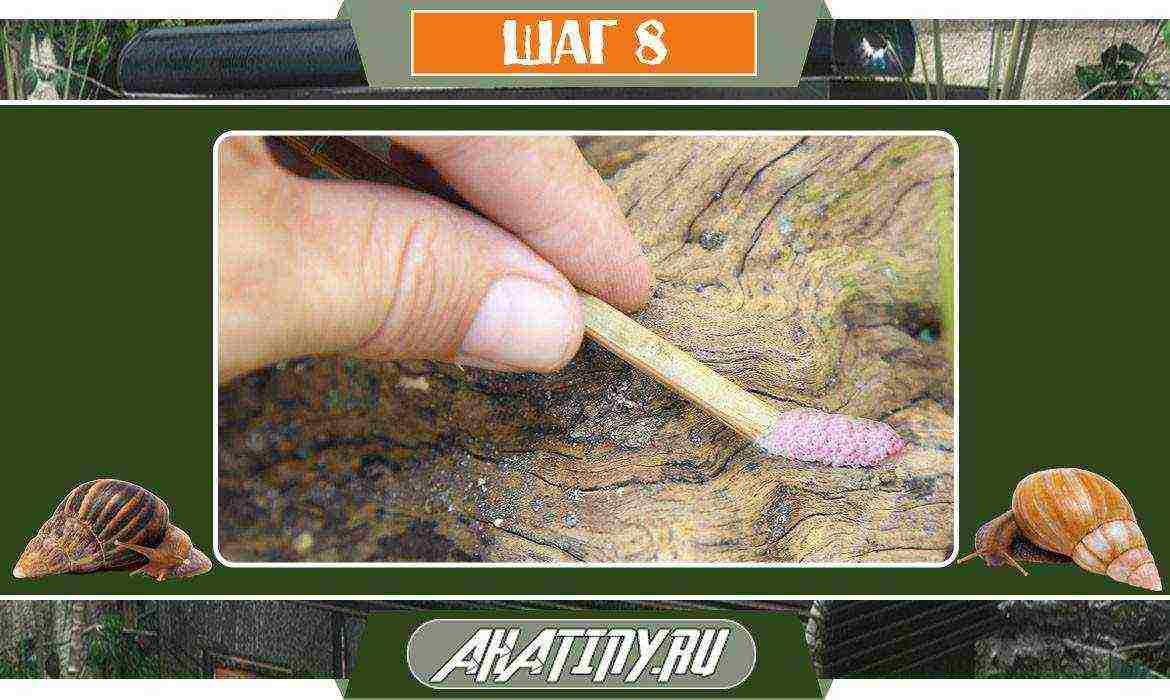
If you don't want dozens or hundreds of small snails, remove all eggs from the soil. Achatina eggs are white or translucent; check the substrate every week for clutches. Freeze unwanted masonry in the freezer.
Wash the terrarium and change the substrate every week
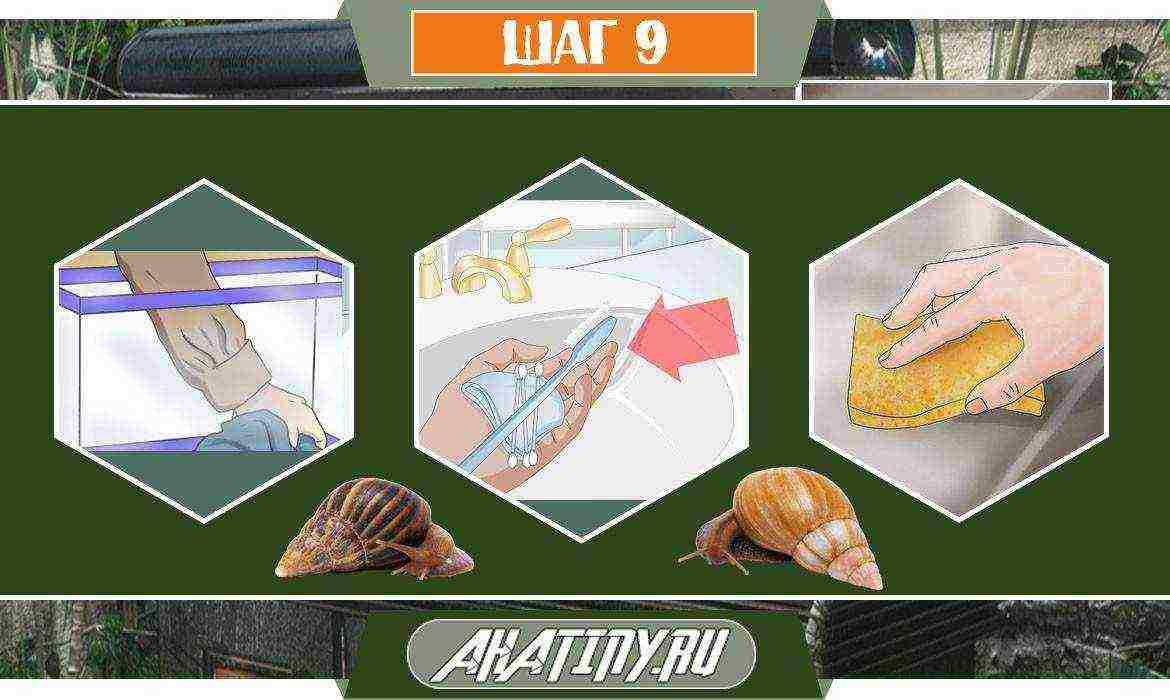
Wash the container with a sponge under warm water without detergents. Then add new soil to a clean terrarium and do not forget to moisten it.
Your snail is healthy
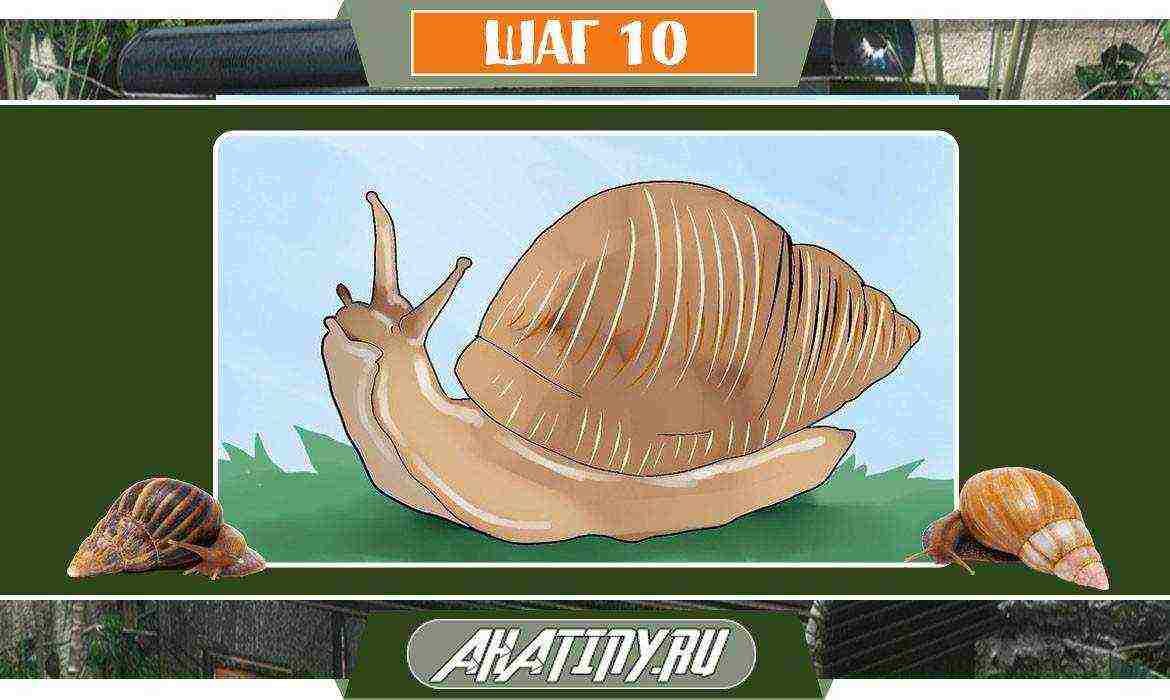
With proper care, home Achatina does not get sick. It is very important that it does not come into contact with salt, sugar and chemicals, including fertilizers and pesticides.
If the terrarium is cold or hot, your snail becomes inactive and closes in the shell.
A healthy Achatina is active, her body is moist and clean, and her shell is strong without dents or chips.
Tips
- Place the enclosure away from direct sunlight, radiators and drafts.
- Place the clam where it can be easily accessed.
- The African snail loves cucumbers and water and needs calcium for its shell.
- Cucumbers have almost no nutritional value for Achatina.
- Do not feed the snail with peaches, because their mucus becomes like water.
- Do not leave moldy food in the terrarium.
- Always wash vegetables with lukewarm water, you rinse off chemicals that can kill your snail.
- Be careful when feeding Achatina with spinach, as large amounts can interfere with calcium absorption.
- The diet of a homemade Achatina should be varied.
African snail care video
Write what kind of African snail lives with you and how you care for it.

Achatina (lat. Achatina) - land gastropods from the subclass Pulmonary snails. This highly invasive species has become widespread in countries with tropical climatic conditions, where it is one of the dangerous pests of many agricultural plants.
Characteristics of Achatina
The average shell length of adult snails, as a rule, does not exceed 50-100 mm, but some specimens are larger than 20 cm. The shell of the snail is conical in shape, most often characteristically twisted exactly counterclockwise.
Age Achatina are characterized by a shell, which has about seven to nine coils. The main color of the shell directly depends on the characteristics of the environment, as well as the diet, but most often it has reddish-brown stripes and yellowish tints.
Back to content
Buying the Achatina snail - tips
Before purchasing, you need to find out the features of caring for a snail and inquire about the diet of the mollusk, its content and care, as well as take into account the main nuances:
- it is not recommended to purchase homemade Achatina from your hands, so it is advisable to visit a pet store and observe the behavior, eating habits and general health of the snail;
- it is important to inspect the terrarium and its equipment, taking into account the volume of the dwelling and its lighting, the presence of a ventilation hole and other accessories;
- African Achatins must have a good pedigree, recorded in special registration documents.
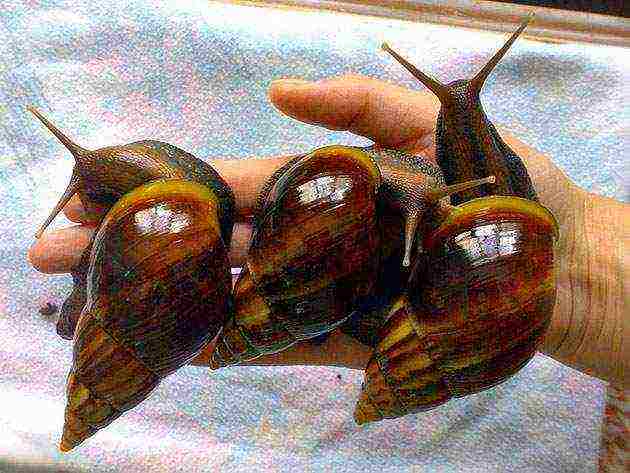
It should be remembered that private individuals who are not professionally engaged in the cultivation of land gastropods do not cull and try to sell snails in large quantities, as well as sell clutches and do not have competence in matters of care or maintenance. Quite often, such people are not able to provide complete information about their mollusks and do not care at all about the health of the animal.
Important! Particular attention should be paid to the appearance of the mollusk. The shell of the snail should not be cracked, and uniformity is a good sign. It is best to purchase Achatina over the age of two months.
Breeders or keepers competently raise snails and are fully competent in the matter of their maintenance. Professionals are not looking for benefits from the sale of snails, therefore, they are able, if necessary, to provide comprehensive information on the origin and pedigree of the mollusk. Breeders make timely culling, but clutching for breeding is never realized.
Back to content
Terrarium device, filling
Any glass or plastic container with a lid with special small ventilation holes can be used as a dwelling for the mollusk.As practice shows, preference should be given to a horizontal type terrarium, and the volume of such a container for one adult cannot be less than ten liters.
Particular attention is paid to heating the terrarium for growing a tropical pet... A thermophilic creature should be provided with a comfortable and stable temperature regime, regardless of the season, at the level of 26-28 ° C. It is preferable to use special external devices for heating the snail's dwelling in the form of safe thermal cords or thermal mats. It is important to prevent not only freezing of the animal, but also its overheating, therefore it is advisable to place a thermometer in the terrarium.
It will also be interesting:
- African snail Achatina
- How to feed Achatina snails
- Grape snail (Нliх romаtia)
Terrarium lighting is important, but additional lighting at night is optional. It is necessary to prevent the sun's rays from falling on the mollusk, therefore, the terrarium must absolutely not be installed on the sill of a south-facing window.
As a filling for a dwelling, you need to choose the right type of soil, for which it is desirable to use a coconut substrate that retains moisture well. The thickness of the soil is selected in accordance with the size of the pet. Before filling, the briquette is poured with boiling water, after which it is cooled, washed and dried. As a quite worthy filling option, you can also use high-moor pure peat with a pH level of 5-7.
Important! It is necessary to place a terrarium with a giant snail in a place where there is no negative effect on the animal from a draft or direct sunlight, as well as excess heat from heating appliances.
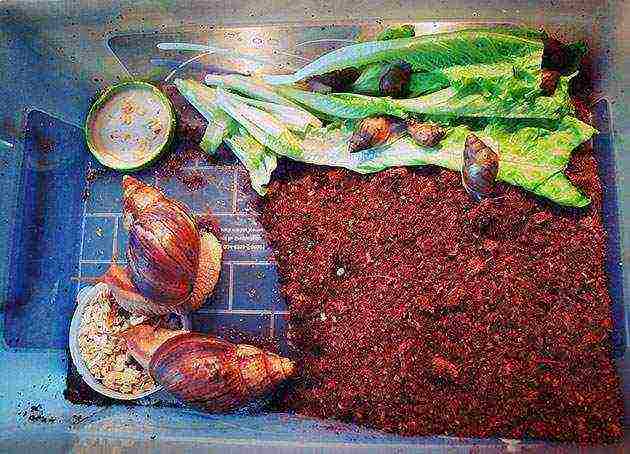
Additional accessories for the snail include high-quality drinking bowls and feeders made from environmentally friendly and soft materials, as well as a pool and a small house. Food grade plastics have proven themselves very well. Do not use sharp or dangerous, too hard objects in the terrarium that can damage the body or shell of the house mollusk. Experienced owners of such pets recommend planting salad crops or special cat grass in the Achatina house. Twigs, picturesque driftwood or traditional tree bark will become a real decoration for the landscape.
Back to content
The correct diet of the Achatina snail
The basis of the Achatina diet is represented by lettuce leaves, a variety of herbs, shoots of cereals and vegetables, as well as tops. The diet of shellfish should also include foods presented:
- cucumber and pumpkin pulp;
- spinach;
- zucchini;
- carrots;
- cobs of young corn;
- peas;
- tomatoes;
- cabbage;
- apple and pear pulp;
- watermelon and melon;
- bananas;
- apricots;
- avocado;
- mango;
- pineapples;
- cherries;
- plum;
- raspberries;
- strawberries.
Adult gastropods can be a little capricious in terms of nutrition, so they often prefer some foods, completely neglecting others. In any case, soft fruits and vegetables are cut into slices, and hard ones are grated or chopped in a kitchen blender until they are puree. Any food given to the snail must be brought to room temperature.
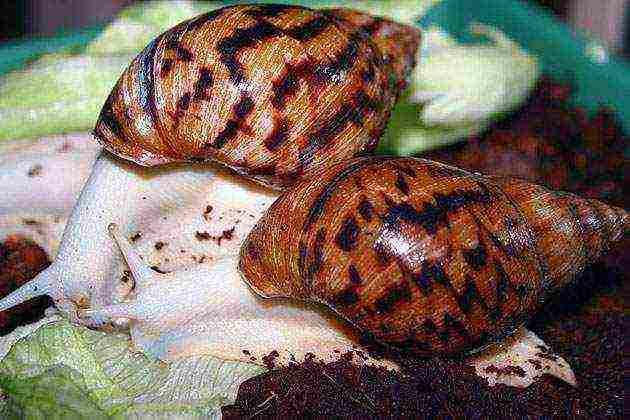
It is forbidden to give your pet food from the common table, spices and fried foods, sweet and sour, as well as smoked and spicy foods.... Natural acids contained in citrus fruits, including lemons, tangerines and oranges, are dangerous for the snail. It is very important to provide the gastropod mollusk with a special mineral feed containing a sufficient amount of calcium.
It is interesting! Pure water is especially important for the gastropod mollusk, which Achatina not only drink, but also very actively use for water procedures.Water must be changed daily.
It is advisable to feed adult domestic snails in the evening, once a day. Small and young individuals should be provided with round-the-clock and unimpeded access to food and water. Food is served in a special bowl or on a tray, which may well be a cabbage or lettuce leaf. Lean food is removed from the terrarium.
Back to content
Achatina care
Such exotic pets do not require special care. Cleaning in the terrarium should be done as soon as it gets dirty, and general cleaning is carried out at least a couple of times a month. Hygienic cleaning of the walls of the enclosure and the inside of the lid is carried out on a daily basis.
It is categorically impossible to use traditional chemical cleaning powders and other means for cleaning, therefore experienced owners of domestic snails advise using hot water and soft rags or an ordinary dish sponge for this purpose.
Important! Please note that any tools used to clean the terrarium must be kept separately.
Gastropods are very fond of taking regular water treatments. Of course, for such exotic pets with a hygienic purpose, it is quite enough to install a shallow pool inside the terrarium, but it is very desirable to periodically arrange a warm shower for the snail, holding the animal in your hand over a regular sink. The stream of water directed at the snail should not be too strong and necessarily warm. The total duration of such a procedure is no more than three minutes.
Back to content
Health, disease and prevention
The main causes of snail disease are most often presented:
- improper maintenance, including hypothermia or overheating of the animal, the use of a too cramped terrarium, the use of dry or swampy soil;
- low-calorie diets with insufficient amounts of protein and calcium;
- rare cleaning in the terrarium, the accumulation of rotting food debris and excrement;
- improper ventilation and poor quality soil;
- violations of the neighborhood of different species and subspecies of domestic snails.
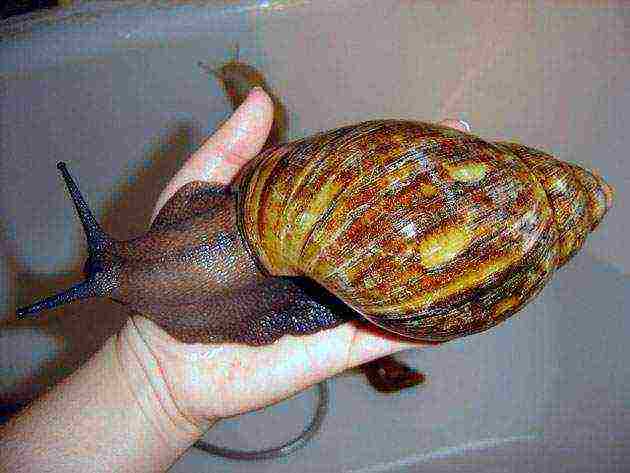
The main signs of illness in a pet are lethargy, complete or partial refusal of food, blockage of the entrance to the shell, excessive or thick mucous discharge, as well as pronounced stratification of the shell. A particular danger is the loss of the gastropod mollusk from the shell, which can be caused by genetic predispositions or prolonged exposure to carcinogens, the influence of bacteria, infections and fungi. The result of such a pathology, as a rule, is the rapid death of the snail. In order to prevent such diseases, it is recommended to competently approach the process of choosing basic feeds and supplements of animal origin.
Important! Particular importance is attached to the observance of preventive measures, including control of the cleanliness of the terrarium, adherence to the correct diet and full care of the home mollusk.
Careless handling of homemade molluscs can cause household damage and damage to the integrity of the shell. Not too large damage is most often corrected with epoxy glue, after which the animal must be provided with a diet enriched with calcium.
The unsanitary conditions of keeping the snail provoke the appearance of parasites and infectious diseases in the pet, which can sometimes be very difficult to get rid of. For treatment of an animal, it is allowed to use propolis-based ointment, as well as the drug "Mikoseptin" and a pharmacy solution of iodine.
Back to content
Reproduction at home
Achatina belong to the category of hermaphrodite animals, therefore they have both male and female reproductive organs.The total duration of the incubation period ranges from 28 to 56 days, which depends on the species characteristics of the gastropods, as well as the conditions of their home keeping. It should be noted that Achatina are extremely fertile, therefore, many owners, in order to curb uncontrolled reproduction, simply wash off the excess clutches of eggs that have appeared.
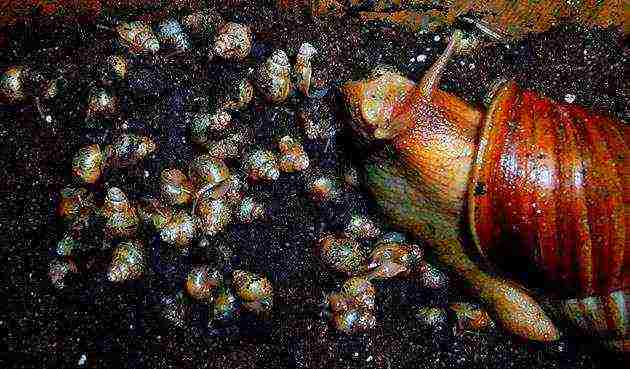
To obtain healthy offspring, it must be remembered that during the incubation period, all cleaning activities are carried out with special care, and increased attention should be paid to controlling and stabilizing the air humidity inside the terrarium. After birth, all newborn snails are deposited from adults.
Instead of a substrate in a home, it is best to use lettuce leaves. The smallest Achatina are fed with liquid porridge with the addition of mashed carrots, which helps to strengthen their shell, and also very well activates growth processes. Among other things, it must be remembered that up to the age of one and a half years, domestic gastropods should not be allowed to breed.
Back to content
Video about the content of the Achatina snail
Back to content
By submitting a comment, you confirm that you agree to the processing of personal data in accordance with the privacy policy
Their favorite pets live next to a person. It is more common to see dogs and cats among them. But many people enjoy breeding animals in aquariums. Artificial mini-ponds in the apartment are intended not only for fish living in them. Some exotic lovers keep snails in them. Achatina is a popular species for captive breeding. About reproduction, egg care and many other things from the life of these leisurely mollusks are told in our article.
Achatina: who is it?
These are large sized snails that live on land in subtropical and tropical climates. Thanks to people, they gradually moved to Southeast Asia, and in the warm countries of this region they successfully took root. Here the process of reproduction of the Achatina snail is quite intensive. They do not care for eggs in the wild, so a large number of them died. However, given that there are more than a hundred eggs in a clutch, the percentage of surviving young is large. Due to the fact that Achatins multiplied extremely, they became pests of young crops, as they eat them at the root.
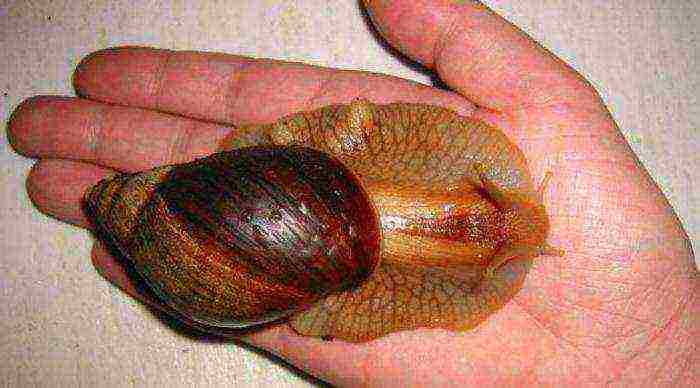
Snails that live in their natural environment are a source of infection with diseases that are dangerous to humans. But Achatina, bred by man, are harmless, there are no dangerous viruses in them.
In Japan, these molluscs are eaten, so they are bred in large quantities. The French also eat them. Snails in Russia are bred as pets. In our harsh outdoor climate, they simply won't survive.
General information about shellfish
Achatina are the most gigantic African snails. They grow up to 30 cm long. Their shells are large and have thick walls, and what color they will be depends on the food used. The shells have coils twisted clockwise and counterclockwise. Old snails have seven to nine such ornaments on their shells. The body of the mollusks is soft, wrinkled, with tubercles all over the surface. It has different colors, but the most common color is alternating stripes of contrasting shades.
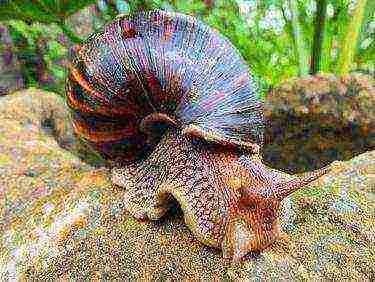
Small horns in the amount of two pairs are the organs of touch of Achatina. Their eyes are located on the first pair of horns. With the help of light-sensitive cells throughout the body, snails perceive light. Molluscs see objects that are one centimeter away from their eyes. They smell smells with their skin, they perceive the shape of objects located at a close distance with the sole. Snails breathe with the skin, since they have no lungs.
How snails mate
So that there are no problems with the breeding of Achatina snails and care behind them, you should not mate mollusks from the same clutch, where they are all relatives to each other: parents, brothers, sisters, children. For reproduction, choose healthy and large snails born in other families. In order for the offspring to be viable and healthy, one species and one species of molluscs are mated.
If you plan to grow large snails, you do not need to rush to reproduction. This is due to the fact that during pregnancy, the growth and formation of molluscs is suspended. Mating before the individuals reach the age of one year is undesirable.
Preparing for breeding
While waiting for the offspring, it is necessary to create conditions for the reproduction of Achatina snails. The aquarium should always have a constant temperature of + 27 + 28 degrees. Its fluctuations during this period are unacceptable.
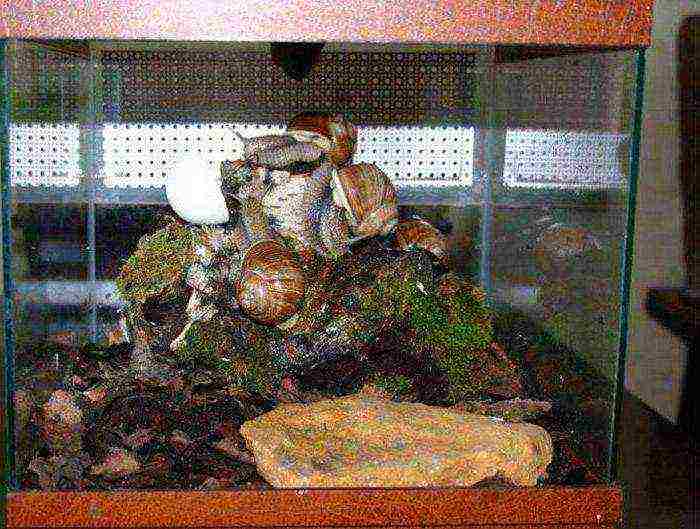
In order to cover the bottom of the snail house, a coconut substrate is used, but not dry, but wet. Its thickness should be 10 cm. The aquarium itself should be cleaned regularly, and the snails should be fed with calcium.
The use of sepia, chalk or mineral stone, small shell rock is what you need. The snail should be provided with a calcium supplement before, during, and after gestation until the mollusk recovers.
How is the breeding process carried out
To breed Achatina snails at home, they must mate. To make this happen, they are transplanted into another aquarium or container. If the individuals are of the same size, fertilization will be bilateral, if their parameters do not coincide, it will be unilateral. The larger snail becomes a female.
At a young age, molluscs produce more male germ cells than female ones. For this reason, for the reproduction process, a young mollusk is planted with adults.
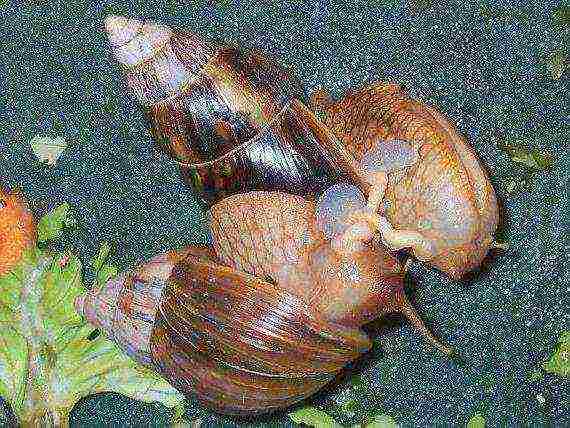
Mating of snails lasts two hours or a little less. With their genitals, they come into contact with each other, exchanging sperm and fertilizing. The body of the mollusk is capable of storing it for two years. The snail can lay eggs every month if conditions are favorable for this.
After mating, egg laying begins. It is now known that all Achatina snails are oviparous, although they differ in terms of gestation. The hatched eggs are clearly visible if you look in the spiracles of the mollusc. From the moment when mating took place, and until the opening of the masonry, it takes one to one and a half months.
How to stimulate reproduction
Many novice breeders are faced with such a problem: despite the good content of the Achatina snail, reproduction still does not occur. What to do? You need to start by making sure that the shellfish are healthy. If everything is in order, their feeding regime and the composition of the diet are checked. Further, the conditions of detention, the thickness of the substrate in the aquarium and its condition are examined. If the litter has not been changed for a long time and it has managed to get dirty, there will be no mating and further reproduction of Achatina snails in such conditions. Experienced breeders stimulate the breeding process by removing the artificial reservoir.
How to care for a snail during pregnancy
Bearing eggs in different species is not the same in time. On average, this period lasts one to two weeks, after which the snail lays 50-300 eggs.
During pregnancy, mollusks consume a lot of strength and energy, therefore, after the mating process, they are very often inactive, burrow into the ground and sleep a lot. Their growth and formation stops.

During this time, it is especially important that the shellfish are not calcium deficient. They need to be fed with food chalk, calcium mixtures. The diet should include cereals, protein supplements, and vegetables.
If Achatins receive a balanced diet, healthy offspring will be born.It is important to maintain the microclimate familiar to mollusks in the aquarium.
A week after the fertilization process, you can already see several eggs. They are located on the side of the airway. This is the future masonry, which the snail lays in the ground, although it happens that on its surface. The Achatina family is large. It contains mollusks that do not lay eggs. Small cubs are born immediately, 20-30 pieces about 9 mm in size.
Achatina snails: reproduction, egg care
Everything is important in growing shellfish, but the reproduction process is the beginning of life. Therefore, you need to create the most comfortable conditions for this. Another, no less important point is egg care. Achatina snails, reproduction of which was carried out according to all the rules, very soon cover the bottom of the aquarium with white eggs. Of these, snails will hatch in 65 days. For some time they will live in the ground, feed on eggshells. An adult lays an average of 50 eggs with a diameter of five millimeters. When breeding the Achatina snail, egg care is essential. If left unattended, the masonry will die. Therefore, the following rules for caring for them should be observed:
- The litter from the soil at the bottom of the aquarium should not dry out, but the accumulation of liquid is also unacceptable. If water covers the nest, the eggs will rot, and all embryos will die in dry soil.
- Eggs can be sprinkled with soil for their safety.
- A higher humidity than usual should be maintained.
- Throughout the entire masonry period, the temperature regime must be observed. The aquarium should be warmer than indoors.
- A large number of snails should not be kept in one house. In cramped conditions, eggs often die.
- Do not touch them with your hands, otherwise you can damage the shell.
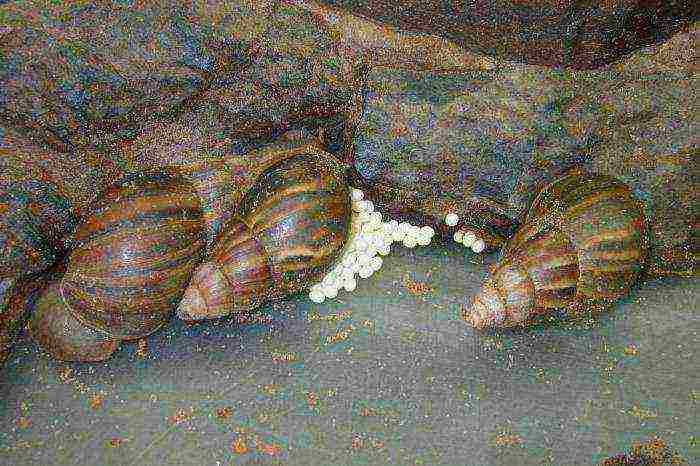
Which clutch of eggs is called false
These are unfertilized eggs in the amount of 10-15 pieces. They do not have a shell, they are translucent in appearance. Such eggs are called fatty eggs. False masonry is a harbinger of the real one, but only if the Achatina has a pair. Lone snails often lay fatty eggs.
Extra eggs: what to do?
It happens that during breeding, the Achatina domestic snail lays many eggs. In this case, experienced breeders are advised to freeze the excess, and then get rid of them. But there is an interesting feature to consider. If eggs are placed in the trash bin, they can hatch into snails even when frozen. Population growth in this case will be uncontrollable. This situation can be avoided if you prepare in advance for this turn of events.
Tiger snails
They are called Ghanaian giant snails. This is another type of terrestrial shellfish in the world. They are harder to breed than African Achatina. Natural habitats include the dense forests of Ghana and coastal thickets.
The shells reach 18 cm in length and 9 cm in diameter. There are cases, although very rare, when the shell grows up to 30 cm. The average life span is 5-7 years.
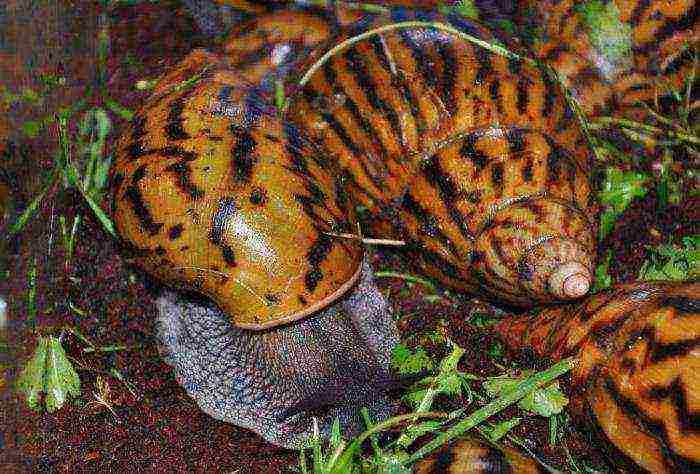
The population of tiger snails has been declining lately due to intensive deforestation. In addition, shellfish are too actively used as food. Significantly, tiger giants often die of malnutrition after laying eggs.
Often snails of other species are mistaken for tiger molluscs, which feature a rough, dark-colored leg with a V-shaped end.
The reproduction of Achatina tiger snails occurs when they reach puberty, that is, their age is 21-24 months, sometimes three years. But this period is reduced if, when keeping at home, it is good to feed your pet. Sometimes reproduction occurs through self-fertilization, but it lasts a long time.It happens that it is five years after the snail laid its eggs for the first time.
